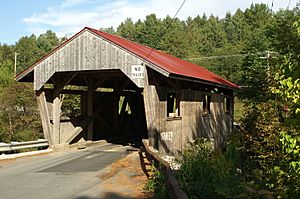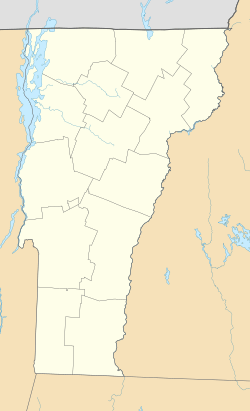Power House Covered Bridge facts for kids
Quick facts for kids Power House Covered Bridge |
|
|---|---|

Bridge in U.S. state of Vermont
|
|
| Carries | Automobile |
| Crosses | Gihon River |
| Locale | Johnson, Vermont |
| Maintained by | Town of Johnson |
| ID number | VT-08-08 |
| Characteristics | |
| Design | Covered, Queen post |
| Material | Wood |
| Total length | 63 ft (19.20 m) |
| Width | 14 ft (4.27 m) |
| Number of spans | 1 |
| Load limit | 8 tons |
| Clearance above | 8.75 ft (2.67 m) |
| History | |
| Constructed by | unknown |
| Construction end | 1870 |
| Area | 1 acre (0.4 ha) |
| NRHP reference No. | 74000231 |
| Added to NRHP | October 9, 1974 |
The Power House Covered Bridge is a special kind of bridge called a covered bridge. It's also known as the School Street Covered Bridge. This historic bridge was built way back in 1870. It crosses the Gihon River in Johnson, Vermont, USA.
The bridge got its name from an old power station that used to be nearby. In 1974, it was added to the National Register of Historic Places. This means it's an important historical site. The bridge uses a special design called a Queen post truss.
What Does It Look Like?
The Power House Covered Bridge is located east of Johnson village. You can find it on School Street, just west of Vermont Route 100C. It crosses the Gihon River, which flows into the Lamoille River.
The bridge is about 63.5 feet (19.4 m) long. That's about the length of two school buses! It is 19 feet (5.8 m) wide, but the road inside is 16 feet (4.9 m) wide, enough for one car. The bridge sits on strong stone foundations.
It has a sloped metal roof, like a house. The outside walls are made of vertical wooden boards. These boards also cover the inside of the bridge entrances. On the sides, the boards don't go all the way to the roof. This leaves an open space along the top.
Inside, the bridge has metal rods and plates. These were added to make the bridge even stronger.
A Look Back in Time
The Power House Covered Bridge was built in 1870. This was many years before the power plant it's named after was built. It is one of only three covered bridges from the 1800s still standing in Johnson.
Over the years, the bridge has had some repairs. In 1960, small fixes were made to its foundations and floor. In 1995, strong steel beams were put underneath the bridge. This was done because many trucks were using the road as a shortcut.
In 2000, something big happened. A very heavy snow load caused the roof to collapse! The side walls fell into the river below. Luckily, because of the steel beams added earlier, the bridge deck (the part you drive on) stayed in place.
Guardrails were put up so the bridge could still be used. In 2002, a company was hired to rebuild the bridge. It was reopened on June 29, 2002, looking like new again!



